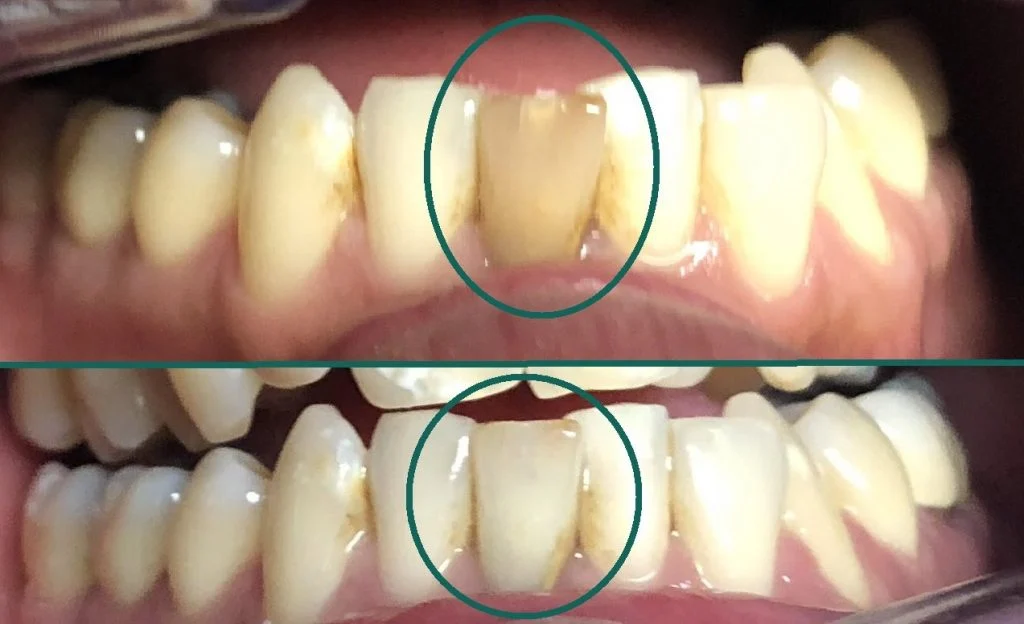
06 May Dead Tooth: Symptoms, Causes and Treatment
One of the most common issues the patients approach dentists with is having a “dead tooth”.
To some patients, there is no stress and they just want a simple solution to their problem. To other anxious patients, there is a lot of fear regarding what may have to take place as they lay back on the dentist’s chair.
A dead tooth is such a frequent problem in dentistry, but you may be wondering what are the exact symptoms and causes – and what can you do to treat it.
What is a Dead Tooth?
If you’re after a simple explanation, a dead tooth is just a tooth that does not have any blood flow to it. An injury to the tooth such as something from playing sports or even just tooth decay can cause a dead tooth.
The human tooth is made up of “layers” – pulp, dentin and enamel. Nerves and blood vessels are essential to the function of teeth, so dead nerves can cause a tooth to be classed as “dead”. There will also be no blood flowing to the tooth for it to be dead.
If you don’t do anything, the tooth will fall out by itself over time. This is not always the best thing to do and dentists recommend that they have a proper inspection. That is because a dead tooth can lead to some pretty bad infection that can spread around the mouth and cause a lot of issues for you.
Symptoms of a Dead Tooth
Sometimes, (especially during the early stages of having a dead tooth) it can be hard to determine if your tooth is actually “dead”.
It’s always a good idea to visit a dentist regularly in order for them to have a professional look at your teeth, and so during these regular visits, they will be able to check for signs of a dead tooth.
The main things to look out for when it comes to having a dead tooth are a darkening of your tooth and discomfort/pain.
Toothaches can cause agony, and teeth are infamous when it comes to pain-related health issues. A dead tooth can actually be extremely painful since nerves are naturally very close to the teeth. Having a dead tooth can also lead to infections, so watch out for foul tastes and smells in the mouth.
A dead tooth will also be darker in colour compared to a normal tooth. Some dead teeth can be completely black, while others turn a dark yellow or greyish colour.
Causes of a Dead Tooth

As mentioned before, an injury to the tooth or tooth decay can cause a dead tooth.
Poor dental hygiene will lead to plaque and tooth decay. Brushing your teeth twice a day will lead to better dental health, as well as avoiding bad foods.
Decay that really gets deep into the tooth and is untreated is likely to cause a dead tooth. The best way to prevent tooth decay is to stop it from happening in the first place.
Injuries that really damage the tooth such as taking a punch while boxing, falls and so on can cause you to have a dead tooth. This can make the blood vessels within the tooth burst, which of course stops the blood supply to the tooth.
Treatments for a Dead Tooth
One of the best things to do to fix a dead tooth is to act sooner rather than later. If you ever think that you may have done something to cause a dead tooth or experience constant and annoying pain, then the best thing to do is to just see a dentist right away.
The main thing that a dentist can do to check for a dead tooth is by giving you an x-ray.
A root canal or the removal of a tooth is currently the best form of treatment for a dead tooth.
Conclusion
A dead tooth can be a cause of concern for many people, but if you act sooner rather than later by seeing a dentist then there will be nothing to worry about.
To summarise: A dead tooth is a tooth that does not have any blood flow to it. It is caused by either tooth decay or trauma to the teeth. It can be treated by having the tooth removed or by having a root canal.
